Face-Off: Assassin's Creed Syndicate
London calling.
Assassin's Creed Syndicate sees Ubisoft redeem its flagship series after the catastrophic launch of last year's Unity. Our initial impressions painted a promising picture: performance is substantially improved, while the gameplay experience is also more stable with little in the way of bugs and glitches. Some crucial changes are made to the engine and there's the sense that Ubisoft has rebalanced the AnvilNext tech for the new game. In effect, this piece isn't just a comparison between Xbox One and PS4 versions of the title - more fascinating are the compromises and improvements made to the core technology in the wake of the Unity debacle.
Tackling the state of the conversion work first, core image quality is left untouched with both consoles handing in a 900p presentation backed up by a post-process anti-aliasing solution that gives the game a soft, but smoothed over appearance - no real change from Unity here. The lack of per-pixel sharpness blurs over some of the more intricate texture and normal map details, although this also helps to reduce the appearance of upscale artefacts as the image is resized to full HD. Image quality could be better, but Ubisoft's solution works as an acceptable compromise given the level of detail and accomplished effects work on offer.
Digging deeper into the game, we're looking at an identical looking set of assets and effects on both versions of Assassin's Creed Syndicate, with fairly low levels of AF (our guess would be 4x) utilised across ground surfaces, matching shadows and lighting, and the same textures and normal maps deployed across characters and environments. Rare variances crop up between platforms, but these seem to take the form of incidental, minor bugs. For example, we noticed some lower resolution textures on PS4 in two areas of the game, but replaying the same section several hours later, we saw complete parity between the assets. In another scene, large lightning bolts appear permanently absent on PS4, though the use of alpha effects is identical elsewhere in the game on both systems.
Exploring London for the first time, Ubisoft's attention to detail continues to impress, and it's fair to say that the world in Assassin's Creed Syndicate is put together with a similar degree of intricacy that made Unity stand out from previous titles in the series. However, exploration of building interiors is reduced with fewer buildings accessible by the player - outposts in gang controlled territory can be explored, along with factories and historic locations that play a key part in the game's story and side missions. Traversing the streets and rooftops, brickwork, debris, and incidental objects are rendered with precision across the scene, while draw distances comfortably extend into the horizon. However, texture detail can be lost at a distance, sometimes giving the game an almost pastel-shaded look - it's something we hope to see improved in the upcoming PC game.
One major difference we see compared to Unity when surveying the vast cityscape comes with the culling of hundreds of NPCs, now down to groups of few dozen citizens in various locations across the city. This gives London a sparser feel than revolutionary Paris, though the city itself doesn't appear overly empty: passing traffic consisting of horse-drawn carriages and handfuls of citizens going about their daily lives still bring a sense of life to the streets. From a graphical perspective, the reduced NPC count also leads to less noticeable pop-in while exploring. There are also dividends to gameplay too: the lack of huge crowds allows for easier traversal - there are simply fewer NPCs getting in your way than there were in Unity.
Lighting has also seen a major shake-up in Assassin's Creed Syndicate with the series returning to a dynamic time of day system, including variable weather conditions and cloud coverage - a positive change overall after the locked TOD system in Unity. Time of day is initially scripted when starting a mission, but once gameplay commences it ticks over in real-time until the story requires specific lighting conditions. The real-time nature of the lighting model means that the beautiful baked global illumination featured in Assassin's Creed Unity has been jettisoned completely for the sequel. The change leads to similar lighting conditions appearing a little more flat compared to Unity, with fewer indirect light sources rendered on-screen. However, the advantage is that dynamic day/night cycles and the visual passing of time add more variety to the look and feel of game.

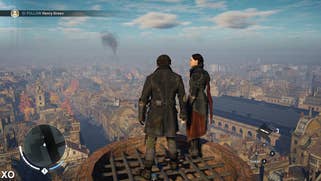
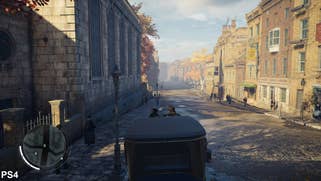
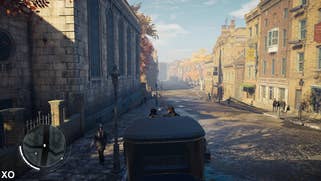
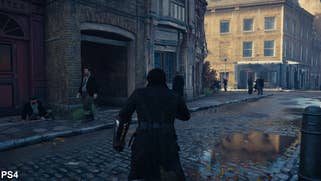
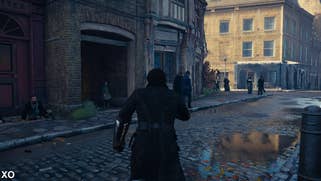







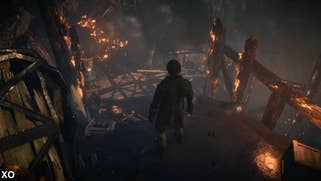
In other areas, the impressive use of physically-based lighting still forms a fundamental part in how the city of London is displayed. Unity's stellar recreation of material properties across different surfaces, such as the differences in the way leather, metals and stone react to light are clearly visible throughout the game. Subsurface scattering is also present on the characters simulating the way light penetrates the transparent properties of the skin. These aspects occasional appear a little less refined compared to Unity, perhaps due to the game featuring a different lighting model to accommodate dynamic time of day transitions. However, it still looks impressive and may yet be using identical tech - getting a precise lock on this is challenging owing to the differences in content.
In terms of performance, Assassin's Creed Syndicate represents a huge improvement over its predecessor, with the game hitting the desired 30fps update with far greater frequency. The masses of NPCs roaming the streets appeared to be the main cause of Unity's woeful frame-rates, which often dived down into the low 20s in busy areas, with the Xbox One frequently enjoying a consistent lead over its PS4 counterpart - presumably owing to its additional CPU power. Only in cut-scenes would PS4 exercise its more capable GPU and power ahead of Xbox One.
With Assassin's Creed Syndicate, frame-rates are visibly improved over Unity across both consoles, with the game achieving the intended 30fps on a more regular basis, resulting in a smoother gameplay experience and less input lag across a general run of play. That said, we also see an interesting turnaround where the PS4 consistently has the advantage during both gameplay and cut-scenes, often performing noticeably faster than the Xbox One game in like-for-like scenarios. In areas where we see PS4 comfortably hit 30fps, the Xbox One game can fall behind, while more demanding scenes see frame-rates drop to a briefly sustained 20fps, compared to around 25fps on the PS4. However, the lead enjoyed by the Sony platform isn't entirely consistent. During collisions between carriages when riding down the London streets - an area where the CPU may be the bottleneck - we see similar drops in frame-rate across both consoles, with metrics falling into the mid-twenties during these scenes.
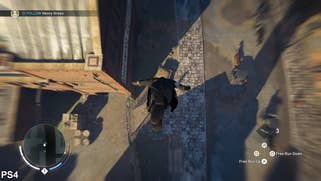
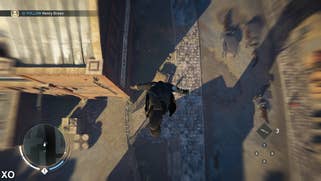


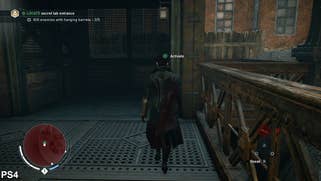

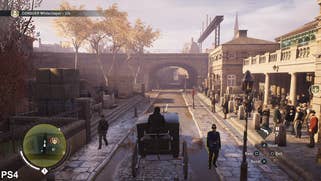
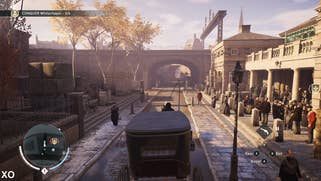




Cut-scenes demonstrate a more consistent - and larger - gap between the two consoles with the PS4 frequently running more smoothly than the Xbox One game in like-for-like scenes. The PS4 game hits the 30fps target for extended periods of time while on Xbox One, frame-rates are often more variable. In slower, dialogue-heavy moments the lack of camera movement means that the performance differential isn't really noticeable, but in action-centric sequences the increased level of stability on PS4 becomes immediately clear. Ubisoft pushes for a higher GPU load here, happier to take the hit to performance knowing that there'll be no adverse impact on gameplay and in this scenario, PS4 offers a closer lock to the target frame-rate.
On the whole, the improved levels of performance make for a smoother gameplay experience on both platforms compared to Unity, and this is further enhanced by subtle tweaks to the core gameplay systems - particularly the all-important parkour system. Characters are less likely to get 'stuck' to scenery while traversing the rooftops, and they have a better sense of balance generally, more in line with Black Flag. There are good improvements to the system overall, but more refinement is still needed.
The series' longstanding problem of the player sticking to unwanted surfaces still remains to a certain extent: sometimes it's easy to lose momentum during a chase when Jacob or Evie latch on to nearby scenery instead of running across or leaping over these surfaces. On the plus side, it's harder to unintentionally run off the edge of a rooftop compared to Unity.
Additional analysis:
Assassin's Creed Syndicate - the Digital Foundry verdict
After over-reaching with Unity, Ubisoft's rebalancing of the current-gen Assassin's Creed technology pays off in Syndicate. Lessons have been learned in just what the current generation of console hardware is realistically capable of, while the key rendering innovations found in Unity remain intact, and even improved in places.
These changes still provide a comfortable visual leap over Black Flag, but the real gains over Unity come in the form of much more consistent performance and increased stability - gameplay is not only smoother but more polished in general, with far fewer bugs and annoyances. The PS4 benefits most from the shift in rendering priorities made in the new title, with the game frequently hitting the desired 30fps update throughout various scenarios - more so than its Xbox One stable-mate, though it's fair to say that both platforms offer a night and day improvement over last year's effort.
So for the short term at least, PlayStation 4 offers a tangibly smoother ride than its Xbox sibling, but there's the sense that the best is perhaps yet to come. The PC version of Assassin's Creed Syndicate is due to arrive on November 18th. Bearing in mind that Unity remains - in our opinion - an absolutely beautiful PC release, we can't wait to see what the higher resolution, pushed back LODs and increased frame-rate add to the experience. Ubisoft's rendering of Victorian London looks good on consoles - based on the Unity experience, it should look magnificent on PC.

















